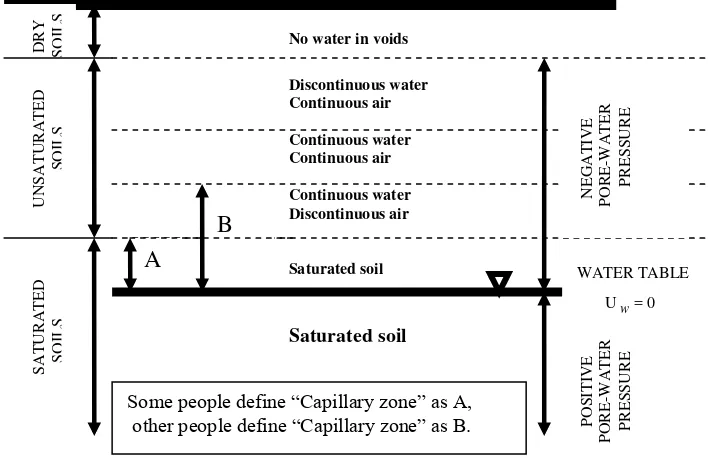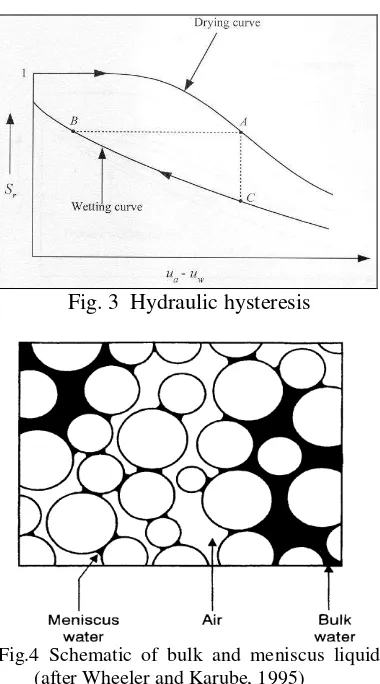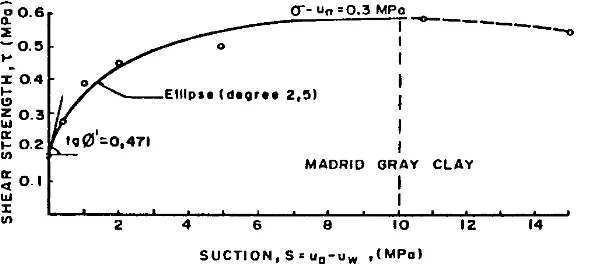UNIVERSITAS VTUHAMMADIYAH SURAKARTA
FAKULTAS TEKNIK
Jt. A, Yani Pabelan Kartasura Tromol Pos 1 Surakarta 57102 Telp. (0271)717417 Ext. 212,213,225,253 Fax. (0271)715448
SURAT
PENGALIHAN
PUBLIKASI
Nomor : 723
/A.Z-VI\I/FT
/III/Z}Is
Yang
bertanda
tangan
dibawah
ini :
Nama
: Ir Sri Sunarjono,
M.T,ph.D
Jabatan : Dekan
Fakultas
Teknik
Menyatakan
menyetujui pengalihan
hak unggah publikasi kepada Lembaga
Pengembangan
Publikasi.
Ilmiah Universitas
Muhammadiyah
Surakarta
atas
artikel berjudul "stress State Variable and Shear Strength Behaviour of
Unsaturated
Soils"
yang di tulis oleh Sri sunarjono NIDN :
06301.263
Dosen
Program
studi Teknik Sipil Fakultas
Teknik universitas
Muhammadiyah
surakarta pada Jurnal Gelagar
No. 02 vol L6 ISSN
: 0853 - 2850 edisi Oktober
2 0 0 5 .
201.5
STRESS STATE VARIABLE AND SHEAR STRENGTH
BEHAVIOUR OF UNSATURATED SOILS
Sri Sunarjono
Department of Civil Engineering, Muhammadiyah University of Surakarta E-mail: [email protected]
ABSTRACT
Mechanical behaviour of an unsaturated soil is commonly viewed as being more complex and more difficult to be understood than that of a saturated soil. This is caused by the presence of pore air and pore water pressure together in the unsaturated soils model. Most of civil constructions are built over soils in unsaturated condition, in contras they are designed using saturated soil mechanics concept that is relatively different with unsaturated soil mechanics concept. This therefore can be understood because unsaturated soils have not been yet implemented in practical work. To produce more realistic solution for various soil mechanics problems, unsaturated soil mechanics have to be ready for application in standard engineering practice. It will require much more research to investigate mechanical behaviour of unsaturated soils that will provide subsequently confidence on the part of the practicing engineer. This paper concern to describe part of mechanical behaviour of unsaturated soils i.e. stress state variable and shear strength behaviour. Unlike saturated soils, two of three stress parameters σ - ua, σ - uw and ua- uw need to describe fully stress state of an unsaturated soil. The relationship between shear strength and suction are not consistent. There need an investigation to clarify this relationship and to develop an equation to calculate shear strength of unsaturated soils.
Key words: unsaturated soils, stress, shear strength, suction
INTRODUCTION
Soils are material that consists of a network of solid particles which enclose voids or pores. The voids may be filled with water or air or both. By this mean, soil is then a multi-phase material consisting of solid (usually mineral particles), liquid (usually water) and gas (usually air). In two-phase condition, soils may contain solids and air (dry condition) or solids and water (saturated condition)
Indonesian soils which classified as tropical soils will be met mostly in
unsaturated condition. It bring
consequence that ideally construction foundations should consider unsaturated soil mechanics. Although the concept of unsaturated soils has not been yet implemented in practical work, engineer should judge some problems caused by unsaturated soils. Therefore, the characteristics of unsaturated soils should be well-understood by engineer.
This paper concern to describe a part of mechanical behaviour of unsaturated soils i.e. development to define stress state variable and shear strength behaviour included reporting of development of oedometer apparatus to use investigating unsaturated soil specimen.
2. CATEGORIES OF UNSATURATED SOILS
Wroth & Houlsby (1985) proposed categories of unsaturated soil on the basis of continuity of the fluid phases. The three different categories proposed are:
Air phase discontinuous and water phase continuous;
Air and water phases both continuous;
Air phase continuous and water phase discontinuous.
The engineering behaviour of an unsaturated soil is commonly viewed as being more complex and more difficult to understand than that of a saturated soil. In many situations in the field the air is connected to the atmosphere, so that relative to atmosphere pressure. The air
pressure (ua) is equal zero (ua=0) and
therefore pore water pressure (uw) will be
negative value (uw≤0). Unsaturated soils generally have negative pore water
pres-sures, but it is the wide range of associated degrees of saturation that produce a broad spectrum of soil behaviour. Fig. 1 shows that an unsaturated soil can be near to 100% saturation in the capillary zone (if capillary zone is as B) and almost dry near the ground surface.
3.UNDERSTANDING OF PORE
PRESSURE AND SUCTION IN THE UNSATURATED SOILS MODEL
Because of pore space of unsaturated soils are filled by air and water, there are two pore pressures i. e. pore air pressure (ua) and pore water pressure (uw). The mechanical behaviour of unsaturated soil is strongly influenced by both the pore air pressure and the pore water pressure. Because of surface tension at the air water interface, so that pore air pressure is not equal by pore water pressure.
The value of pore air pressure is always higher than the pore water pressure (ua≥ uw) because the contact angle
that measured on the water side and a function of the material properties of the liquid, water and soil particle is very small (approaching 0o).The difference between the pore
air pressure and the pore water pressure
is defined as
the „matrix suction‟ or
called as „suction‟. This value is
depend upon the surface tension (T)
and the principle radii of curvature of
the menisci (r
1and r
2), and then there
is equation below
uwr1d
1 r2d
2- uar1d
1 r2d
2+2Tr1d
1sin2
2
d+2Tr2d
2sin2
1
d=0 (1)
ua-uw=T( 1
1 r + 2
1
r ) (2)
where air-water interface at 200 C the value of T = 0.07257 N/m
As a soil is gradually dried from a fully saturated state, at Sr=1, the water within the soil retreats into smaller and smaller voids. The air-water interfaces become increasingly curved, and the matrix suction ua- uw rises as the degree
of saturation Sr falls.
The curve of degree of saturation Sr against matrix suction is called the water retention curve or soil-water characteristic curve. The water retention curve for a given soil is not unique because drying paths and wetting paths follow different curves. This is known as hydraulic hysteresis (Fig 2). The reason for hydraulic hysteresis is that when a given void is
about to empty of water at A during a drying path the menisci are at the narrow entry points to the void (the radius of curvature is therefore small and the matrix suction correspondingly high), whereas when the same void is about to re-fill with water at B during a wetting path the menisci are about to coalesce at location well inside the narrowest entry points (the radius of curvature is therefore larger, and the matrix suction correspondingly lower).
Fig. 3 shows that there are two type of pore water within an unsaturated soil, i. e. bulk liquid and meniscus liquid. The negative pore water pressure within bulk water acts in the same way as in a saturated soil (except that it acts in only the water-filled voids) whereas the negative pressure within meniscus water produces an additional inter-particle force that is
Fig. 1 Classification of the regions within a saturated-unsaturated soil profile
No water in voids
Discontinuous water Continuous air Continuous water Continuous air Continuous water Discontinuous air Saturated soil Saturated soil S A TU R A TED U N S A TU R A TED D R Y SO ILS S O IL S S O ILS N EG A TI V E P O R E -W A TER P R ESS U R E WATER TABLE
Uw= 0
P O S ITI V E P O R E -W A TER P R ESS U R E
A
B
4
normal to the inter-particle contact at each particle contact. To illustrate this, consider the idealised case of a lens of meniscus liquid at the contact between two spherical particles in Fig. 4, with pore liquid confined by a meniscus, and gas at higher pressure acting outside it.
Fig. 3 Hydraulic hysteresis
Fig.4 Schematic of bulk and meniscus liquid (after Wheeler and Karube, 1995)
4. STRESS STATE VARIABLES a. Attempts to define a single effective stress
Terzaghi (1936) stated that all the measurable effects of a change in stress, such as compression, distortion and a change in shearing resistance are
exclusively due to changes in the effective stress.
Fig. 4 Inter-particle force (after Wheeler and Karube, 1995)
In saturated or dry soil the effective stress (σ‟) is found to be equal to the total stress (σ) minus the pore fluid pressure (u): σ‟ = σ - u (3) Bishop (1959) proposed the equation of effective stress for unsaturated soils: σ‟ = σ –χ uw - (1- χ) ua
= σ - ua + χ (ua- uw) (4)
ua was the pore air pressure, uw was the pore water pressure and χ was a parameter which was unity for saturated soils and decrease as the degree of saturation fell, reaching zero for dry soils.
Jenning and Burland (1962) stated that if the single effective stress concept were valid, swelling of soil sample would be expected during wetting due to the reduction in the effective stress as proposed by Bishop (1959). The reduction in soil volume sometimes observed during wetting (collapse compression) was exactly the reverse of the behaviour predicted by Bishop equation and this case serious doubt on the single effective stress concept as applied to volume change. Jennings and Burland (1962) suggested a two-way mechanism to explain collapse
N = Normal component of
interparticle force due to external stress
T= Tangential compo nent of
inter-particle force due to external stress
N
s= Inter-particle force due to
behaviour on wetting of unsaturated soils as follow:
a) bonding between the saturated soil packets will be removed, resulting in collapse of the packet structure into the air-filled inter-packet voids;
b) each saturated packet take in water and swells i.e. collapse of the macro-structure, but swelling of the micro-structure of each packet.
The overall volume changes depend upon the void ratio within the packet and the strength of each packet available to prevent breakdown.
There is apparent unable to represent collapse compression on wetting by Bishop equation (1959). There was other idea that a single effective stress approach might work if there were only bulk water (similar condition with saturated soils). It is the presence of meniscus water which causes the difficulties. An increase of suction within meniscus water (as uwgoes more negative) increases the normal forces at inter-particle contacts. This has several effects.
a) Elastic strains. A rise of suction
causes elastic deformation of particles, produce elastic compression of soil. This is like an increase in effective stress in a saturated soil.
b) Plastic strains. Increasing the normal
force without change of tangential force will reduces possibility of slippage of frictions inter-particle contacts. This will be followed by reducing the possibility of yielding and occurring the plastic strains. This is like a decrease in effective stress in a saturated soil.
c) Shear strength. Increasing the normal
force at inter-particle contacts will be followed increasing shear strength.
This is like an increase in effective stress in a saturated soil.
These mean that an increase in suction within meniscus water is, in some sense, like an increase in effective stress, but, in other senses, like a decrease in effective stress. By this mean, it can not just combine
, uaand uwinto single effective stress. It is not just Bishop‟s equation that is wrong, but there can no satisfactory definition of a single effective stress for unsaturated soils.Fig.5 q-p at critical state
Fig. 6 v-p at critical state
6
(s=100 kPa) is at the same effective stress as a specific saturated sample (s=0). The two samples would have to have identical properties. Unsaturated sample A has same shear strength as saturated sample B, but same value of v as saturated sample C.
b. Use of two stress state variables The failed attempting to represent all the effects of suction within a single stress parameter show the mechanical behaviour of unsaturated soils cannot be described in terms of a single state parameter, but an additional stress parameter is required.
Coleman (1962) and Bishop and Blight (1963) is the earliest use of two independent stress variables. Bishop and Blight then suggested a modified effective stress equation that may be expressed in quite general form, in which the effective stress was function of
- ua and ua- uw: σ‟ = σ - ua + f (ua- uw) (5)Matyas and Radhakrishna (1968) adopted the net stress σ - ua and the
matrix suction ua- uw as the independent stress variables to describe the mechanical behaviour of unsaturated soils.
Fredlund and Morgenstern (1977) stated that any two of the three stress parameters σ - ua, σ - uw and ua- uw would be sufficient to describe fully the stress state of an unsaturated soil. The stress σ - uaand σ - uw are tensor
quantities, whilst the suction ua- uwis a scalar quantity. The combination of net stress σ - ua and the matrix suction ua-
uw is usually selected, because uais commonly zero (relative to atmospheric pressure) in the field, and the net stress and
the matrix suction then simplify to the total stress and the negative pore water pressure respectively. In addition, the pore water pressure in an unsaturated soil is generally negative, which is often difficult to measure accurately. This means an element of uncertainty will be only one stress variable if σ - ua and ua- uw are selected, whereas the uncertainty will affect both the variables if σ - uw and ua- uw are adopted.
Alonso, Gens and Josa (1990) proposed a critical state framework for unsaturated soil involving 4 state variables: mean net stress
p
, deviator stress q, suction s and specific volume v, where v were defined in the normal way and p, q and s were given by:p
= ua
3
3 2
1
(6)
q =
1 -
3 (7)s = ua- uw (8)
5. SHEAR STRENGTH BEHAVIOUR The shear strength of a soil is the maximum shear stress that can be applied to the soil. When this maximum has been reached, the soil is regarded as having failed, the strength of the soil having been fully mobilized.
normal to that plane and has equation below.
f = c‟ + (
n- u) tan
‟ (9)where
n is the total stress normal to the plane, u is the pore-water pressure, c‟ is the cohesion intercept and
‟ is the angle of shearing resistance, with respect to effective stress.Fredlund, Morgenstern and Widger (1978) proposed the equation for the shear strength of unsaturated soils that was predicted a linear increase of strength with suction (ua- uw).
f = c‟ + (
-u
a) tan
‟+(ua-uw) tan
b (10)where
-u
a is net stress normal to plane of shearing, c‟ and
‟ are cohesion and friction angle for saturated conditions andb
is friction angle with respect to suction. Escario and Saez (1986) conducted drained direct shear tests on compacted Madrid clayey sand and have shown thatb
is not constant. At low suctions,
bwill be approximately equal
‟ and thenFig. 7 Failure strength plotted for Madrid clayey sand (Escario and Saez, 1986)
8
tended to decrease as suction increased (Fig. 7). Escario and Saez also concluded that the value of
‟ was unaffected by changes of the suction. Gan, Fredlund and Rahardjo (1988) also observed the non-linearity of shear strength with suction in triaxial tests conducted on a glacial till.Escario and Juca (1989) examined the shear strength of unsaturated soil in a wide range of suction values from 0 to 14 MPa. Fig. 8 shows the shear strength envelope plotted against suction on Madrid gray clay at a constant value of net normal stress. The shear strength reached a maximum at a particular value of suction and then started to fall and to be a negative value. Theoretically if the suction increases indefinitely the soil must ultimately reach a dry state and equation 10 should reduce to the normal Mohr-Coulomb relationship for
dry soil.
6. CONCLUSSION
a. The mechanical behaviour of an unsaturated soil is commonly viewed as being more complex and more difficult to be understood than that of a saturated soil.
b. To describe fully stress state of an unsaturated soils, there need two of three stress parameters σ - ua, σ - uw
and ua- uw.
c. The result of investigation of relationship between shear strength and suction are not consistent. There need an investigation to clarify this relationship and to develop an equation to calculate shear strength of unsaturated soil.
REFERENCES
Bishop, A.W. 1959. The principle of effective stress. Tek Ukeblad, Vol.39, pp 859 – 863. Coleman, J.D. 1962. Stress strain relations for partly saturated soil. Correspondence to
Geotechnique, Vol. 12(4), pp. 348-350.
Escario,V. and Saez, J. 1986. The shear strength of partly saturated soils. Geotechnique, Vol. 36(3), pp 453-456.
Escario,V.and Juca, J.F.T. 1989. Strength and deformation of partly saturated soils. Proc. 12thICSMFE, Rio de Janeiro, Vol. 1, pp. 43-46.
Fredlund, D.G., Morgenstern, N. R. 1977. Stress state variables for unsaturated soils. J. Geotech. Eng. Div., ASCE, Vol. 103 (GT5), pp. 447-466.
Fredlund, D.G., Morgenstern, N. R. and Widger, R. A. 1978. The shear strength of unsaturated soils. Canadian Geotechnical Journal, Vol. 15(3), pp 313-321
Jenning, J.E.B and Burland, J.B. 1962. Limitations to the use of effective stresses in partially saturated soils. Geotechnique, Vol. 12(2), pp 125-144.
Matyas, E.L. and Radhakrishna, H.S. 1968. Volume change characteristics of partially saturated soil. Geotechnique, Vol. 18(4), pp 432 – 448.
Wheeler, S.J. Problem soils–Unsaturated soils. Unpublished lecture note of MSc in Geotechnical Engineering, Department of Civil Engineering, University of Glasgow. Wheeler, S.J. and Sivakumar, V. 1995. An elasto-plastic critical state framework for
unsaturated soils. Geotechnique, Vol. 45(1), pp 35 – 53.


